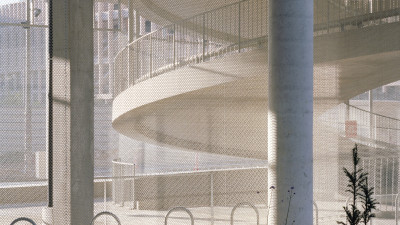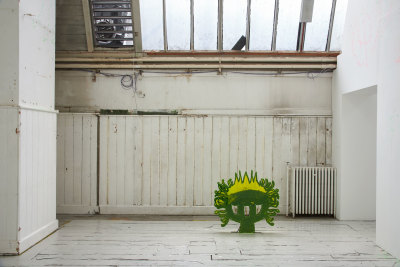The month in architecture
The month in architecture
Everything you need to know that happened in September 2015
By Helena Cuss
Published 28 September 2015
The biggest architecture news, the weirdest new projects and the latest prizes – rounded up into one handy post each month.
-
Further destruction at Palmyra
Satellite photos released by the UN at the beginning of this month show the extent of damage that radical group ISIS have inflicted on the ancient city Palmyra, an event feared by many since they seized control of that area. The largest building on the heritage site, the Temple of Bel, has been completely destroyed bar two columns. It was built in 32AD in the Greco-Roman style fused with near eastern architecture. Its pillars are believed to have inspired the American architects who designed the White House and the Capitol building. Read more on BBC News.
Richard Rogers opens prefab homes for the homeless
One of the UK’s most famous architects has designed residences for the YMCA to house 36 young homeless people in South London. Y:Cube features easy-assembly one-bed 26m² apartments which have a combined living room and kitchen with a separate en-suite bedroom. Stacked on top of one another and brightly coloured, the flats take just one week to build and cost £30-35,000. Rogers’ partner, Ivan Harbour, claims that the units are even “more robust than mass-market housing of equivalent scale”, and hopes that the scheme will help residents save money for a future home in the private housing sector. Find out more from the architects.
Walkie Scorchie wins Carbuncle Cup
The Walkie Talkie building, formally known as 20 Fenchurch Street, has been awarded the dubious prize of the worst building of the year by Building Design magazine. Causing gale-force winds which have literally knocked pedestrians off their feet, and creating rays of light so hot they have melted cars and can fry eggs, it is without doubt among the city’s most unsafe buildings – as well as the most resented. Originally planned with a rooftop Sky Garden which would be open to all, in reality this utopian oasis became a paltry collection of rockeries accessible only by booking three days in advance or by eating at one of the outrageously overpriced restaurants.
Read more about the decision and see past winners on BDonline.
-

Temple of Bel, Palmyra, before its destruction

Buoyant Starts Floating Homes

Drone footage showing Palmyra and the Temple of Bel area before and after destruction, 2015

Y:Cube
-
Housing crisis ideas competition launched
NLA have teamed up with the Mayor of London to launch an international competition to solve the housing crisis, the results of which were revealed this week. Of the 100 top entries over 50 came from architects, including top UK firms Rogers Stirk Harbour + Partners, Grimshaw, Farrells, Feilden Clegg Bradley Studios and Mae Architects. Ideas featured “up-cycled” terrace houses with an extra storey and roof terrace extension on top; building between the gaps in traditional semi-detached housing to supply 100,000 new households; floating starter homes on London’s canals; and easy custom built housing, to name a few. The ten winning designs will be announced next month and their designers will be invited to join Greater London Authority to see if their ideas could be applied to real sites in the city. See the designs at New London Architecture.
Foster + Partners reveals Africa drone port plans
One of the UK’s topmost architecture firms has confirmed its plans to build a drone port in Rwanda to facilitate the flying of urgent medical supplies to remote parts of the region, much of which is inaccessible by road. The design includes a health clinic, digital fabrication shop, post room and e-commerce trading hub, as well as landing space for life-saving drones. If the pilot project (expected to complete in 2020) is successful the architects hope to build more than 40 drone ports in Rwanda and expand to other countries. The design itself takes the form of a series of brick vaults, sitting on top of a hill. Explore the project at Foster + Partners.
NBBJ want to get London walking
An architecture practice better known for designing hospitals has revealed proposals to replace the Circle Line on the London Underground with a set of giant travellators. Featuring a colour-coded, three-speed moving walkway, which would enable commuters to avoid congested carriages during rush hour. Featuring three different speeds between 3mph and 15mph, pedestrians walking at the top speed would be able travel faster than existing Tubes when moving at the average walking pace. See more ideas for Tube regeneration from Guardian Cities.
3D printed pod for Martian living proposed
The reality of humans living on Mars may still be a while away yet, but that hasn’t stopped a 3D-printing company from joining with a team of scientists, architects and image specialists to imagine a basic living pod, known as Sfero, which would be printed on Mars itself. A central drilling rod would burrow several metres into the planet’s iron oxide-rich soil and extract the metal as the raw material for the 3D-printing process, using laser technology. The design features two domes with a protective layer of water between them, with levels above and below ground linked by a spiral staircase. See the design on the Fabulous website.
Zaha Hadid RA wins RIBA Gold Medal
Dame Zaha Hadid RA has become the first female architect in her own right to be awarded the Royal Institute of British Architects’ Gold medal, an accolade given in recognition of a lifetime’s work. Hadid has a habit of breaking gender records in her industry, becoming the first woman to be awarded the prestigious Pritzker Arhcitecture Prize in 2004 and the Design Museum Design of the Year Award in 2014. She also had two Stirling Prizes under her belt, and is best known in the UK for designed the Aquatics Centre for the 2012 London Olympics. Explore her past and current projects on the Zaha Hadid Architects website.
-

Custom Build

Floatopolis

Droneport workshop

Walk the Line











